A Bibliometric Analysis of Research on Stochastic Mortality Modelling and Forecasting
Abstract
1. Introduction
2. Methodology
2.1. Bibliometric Analysis
2.2. Data Collection
2.3. Data Analysis
3. Results and Discussion
3.1. Performance Analysis: Publication Growth
3.2. Analysis on Most Active Authors, Sources and Countries
3.3. Science Mapping: Co-Occurrences of Keywords
3.4. Emerging Research Topic and Future Research
3.4.1. Machine Learning
3.4.2. Development of New Model and Approach
3.4.3. Generalised Age–Period–Cohort (GAPC) Models
3.4.4. Lee–Carter Mortality Model
3.5. Co-Occurrences of Keywords: COVID-19 Mortality Modelling and Forecasting
4. Conclusions
Author Contributions
Funding
Data Availability Statement
Acknowledgments
Conflicts of Interest
References
- Albani, Vinicius, Jennifer Loria, Eduardo Massad, and Jorge Zubelli. 2021. The impact of COVID-19 vaccination delay: A data-driven modeling analysis for Chicago and New York City. Vaccine 39: 6088–94. [Google Scholar] [CrossRef]
- Andrés-Sánchez, Jorge de, and Laura González-Vila Puchades. 2019. A fuzzy-random extension of the Lee-Carter mortality prediction model. International Journal of Computational Intelligence Systems 12: 775–94. [Google Scholar] [CrossRef]
- Arana-Barbier, Pablo José. 2020. The quantitative and qualitative scientific production: A bibliometric study of the five main Asian economies in R&D. Malaysian Journal of Library & Information Science 25: 95–109. [Google Scholar]
- Aria, Massimo, and Corrado Cuccurullo. 2017. bibliometrix: An R-tool for comprehensive science mapping analysis. Journal of Informetrics 11: 959–75. [Google Scholar] [CrossRef]
- Ayerbe, Luis, Salma Ayis, Siobhan Crichton, Anthony Rudd, and Charles Wolfe. 2014. Explanatory factors for the increased mortality of stroke patients with depression. Neurology 83: 2007–12. [Google Scholar] [CrossRef] [PubMed]
- Baas, Jeroen, Michiel Schotten, Andrew Plume, Grégoire Côté, and Reza Karimi. 2020. Scopus as a curated, high-quality bibliometric data source for academic research in quantitative science studies. Quantitative Science Studies 1: 377–86. [Google Scholar] [CrossRef]
- Badhwar, Vinay, Eric Peterson, Jeffrey Jacobs, Xia He, Matthew Brennan, Sean O’Brien, Rachel Dokholyan, Kristopher George, Steven Bolling, David Shahian, and et al. 2012. Longitudinal outcome of isolated mitral repair in older patients: Results from 14,604 procedures performed from 1991 to 2007. Annals of Thoracic Surgery 94: 1870–79. [Google Scholar] [CrossRef]
- Boonen, Tim, and Hong Li. 2017. Modeling and forecasting mortality with economic growth: A multipopulation approach. Demography 54: 1921–46. [Google Scholar] [CrossRef]
- Booth, Heather, and Leonie Tickle. 2008. Mortality modelling and forecasting: A review of methods. Annals of Actuarial Science 3: 3–43. [Google Scholar] [CrossRef]
- Booth, Heather, John Maindonald, and Len Smith. 2002. Applying Lee-Carter under conditions of variable mortality decline. Population Studies 56: 325–36. [Google Scholar] [CrossRef]
- Bozikas, Apostolos, and Georgios Pitselis. 2018. An empirical study on stochastic mortality modelling under the age-period-cohort framework: The case of Greece with applications to insurance pricing. Risks 6: 44. [Google Scholar] [CrossRef]
- Bravo, Jorge. 2020. Longevity-linked life annuities: A Bayesian model ensemble pricing approach. Paper presented at 20th Conference of the Portuguese Association of Information Systems, Portugal, October 16–17. [Google Scholar]
- Brouhns, Natacha, Michel Denuit, and Jeroen Vermunt. 2002. A Poisson log-bilinear regression approach to the construction of projected lifetables. Insurance: Mathematics and Economics 31: 373–93. [Google Scholar] [CrossRef]
- Bucher, Slavomír. 2018. Bibliometric analysis of Central European journals in the Web of Science and JCR Social Science Edition. Malaysian Journal of Library & Information Science 23: 95–110. [Google Scholar]
- Cairns, Andrew, David Blake, and Kevin Dowd. 2006. A two-factor model for stochastic mortality with parameter uncertainty: Theory and calibration. Journal of Risk and Insurance 73: 687–718. [Google Scholar] [CrossRef]
- Cairns, Andrew, David Blake, and Kevin Dowd. 2008. Modelling and management of mortality risk: A review. Scandinavian Actuarial Journal 2008: 79–113. [Google Scholar] [CrossRef]
- Cairns, Andrew, David Blake, Kevin Dowd, Guy Coughlan, David Epstein, Alen Ong, and Igor Balevich. 2009. A quantitative comparison of stochastic mortality models using data from England and Wales and the United States. North American Actuarial Journal 13: 1–35. [Google Scholar] [CrossRef]
- Cairns, Andrew, David Blake, Kevin Dowd, Guy D. Coughlan, David Epstein, and Marwa Khalaf-Allah. 2011. Mortality density forecasts: An analysis of six stochastic mortality models. Insurance: Mathematics and Economics 48: 355–67. [Google Scholar] [CrossRef]
- Carter, Lawrence, and Ronald Lee. 1992. Modeling and forecasting US sex differentials in mortality. International Journal of Forecasting 8: 292–411. [Google Scholar] [CrossRef]
- Currie, Iain. 2006. Smoothing and Forecasting Mortality Rates with p-Splines, Conference Presentation, Institute and Faculty of Actuaries. Available online: http://www.actuaries.org.uk/documents/smoothing-and-forecasting-mortality-rates-p-splines-slides (accessed on 26 July 2022).
- De Jong, Piet, and Leonie Tickle. 2006. Extending Lee-Carter mortality forecasting. Mathematical Population Studies 13: 1–18. [Google Scholar] [CrossRef]
- Delwarde, Antoine, Michel Denuit, and Paul Eilers. 2007. Smoothing the Lee-Carter and Poisson log-bilinear models for mortality forecasting: A penalized log-likelihood approach. Statistical Modelling 7: 29–48. [Google Scholar] [CrossRef]
- Demirel, Duygun Fatih, and Melek Basak. 2017. Human mortality modeling with a fuzzy approach based on singular value decomposition technique. Studies in Computational Intelligence 669: 197–215. [Google Scholar]
- Deng, Yinglu, Patrick Brockett, and Richard MacMinn. 2012. Longevity/mortality risk modeling and securities pricing. Journal of Risk and Insurance 79: 697–721. [Google Scholar] [CrossRef]
- Donthu, Naveen, Satish Kumar, Debmalya Mukherjee, Nitesh Pandey, and Weng Marc Lim. 2021. How to conduct a bibliometric analysis: An overview and guidelines. Journal of Business Research 133: 285–96. [Google Scholar] [CrossRef]
- Fuller, Gordon Ward, Jeanine Ransom, Jay Mandrekar, and Allen Brown. 2016. Long-term survival following traumatic brain injury: A population-based parametric survival analysis. Neuroepidemiology 47: 1–10. [Google Scholar] [CrossRef] [PubMed]
- Halasz, Geza, Michela Sperti, Matteo Villani, Umberto Michelucci, Piergiuseppe Agostoni, Andrea Biagi, Luca Rossi, Andrea Botti, Chiara Mari, Marco Maccarini, and et al. 2021. A machine learning approach for mortality prediction in COVID-19 pneumonia: Development and evaluation of the Piacenza score. Journal of Medical Internet Research 23: e29058. [Google Scholar] [CrossRef]
- Hanewald, Katja. 2011. Explaining mortality dynamics: The role of macroeconomic fluctuations and cause of death trends. North American Actuarial Journal 15: 290–314. [Google Scholar] [CrossRef]
- Härdle, Wolfgang Karl, and Alena Myšičková. 2009. Stochastic Population Forecast for Germany and Its Consequence for the German Pension System. SFB 649 Discussion Paper No. 2009-009. Berlin: Humboldt University of Berlin, Collaborative Research Center—Economic Risk. [Google Scholar]
- Heligman, Larry, and John Pollard. 1980. The age pattern of mortality. Journal of the Institute of Actuaries 107: 49–80. [Google Scholar] [CrossRef]
- Hyndman, Rob, and Md Shahid Ullah. 2007. Robust forecasting of mortality and fertility rates: A functional data approach. Computational Statistics & Data Analysis 51: 4942–56. [Google Scholar]
- Iuliano, Danielle, Howard Chang, Neha Patel, Ryan Threlkel, Krista Kniss, Jeremy Reich, Molly Steele, Aron Hall, Alicia Fry, and Carrie Reed. 2021. Estimating under-recognized COVID-19 deaths, United States, March 2020-May 2021 using an excess mortality modelling approach. The Lancet Regional Health-Americas 1: 100019. [Google Scholar] [CrossRef]
- Janssen, Fanny. 2018. Advances in mortality forecasting: Introduction. Genus 74: 21. [Google Scholar] [CrossRef]
- Karhade, Aditya, Quirina Thio, Paul Ogink, Christopher Bono, Marco Ferrone, Kevin Oh, Philip Saylor, Andrew Schoenfeld, John Shin, Mitchel Harris, and et al. 2019. Predicting 90-day and 1-year mortality in spinal metastatic disease: Development and internal validation. Neurosurgery 85: E671–E681. [Google Scholar] [CrossRef] [PubMed]
- Kasavan, Saraswathy, Sumiani Yusoff, Mohd Fadhli Rahmat Fakri, and Rusinah Siron. 2021. Plastic pollution in water ecosystem: A bibliometric analysis from 2000 to 2020. Journal of Cleaner Production 313: 127946. [Google Scholar] [CrossRef]
- Khairi, Siti Shaliza, Mohd Aftar Abu Bakar, Mohd Almie Alias, Sakhinah Abu Bakar, Choong-Yuen Liong, Nurwahyuna Rosli, and Mohsen Farid. 2021. Deep learning on histopathology images for breast cancer classification: A bibliometric analysis. Healthcare 10: 10. [Google Scholar] [CrossRef] [PubMed]
- Koissi, Marie-Claire, and Arnold Shapiro. 2006. Fuzzy formulation of the Lee-Carter model for mortality forecasting. Insurance: Mathematics and Economics 39: 287–309. [Google Scholar] [CrossRef]
- Lee, Ronald. 1993. Modeling and forecasting the time series of US fertility: Age distribution, range, and ultimate level. International Journal of Forecasting 9: 187–202. [Google Scholar] [CrossRef]
- Lee, Ronald, and Lawrence Carter. 1992. Modeling and forecasting U.S. mortality. Journal of the American Statistical Association 87: 659–71. [Google Scholar] [CrossRef]
- Lee, Ronald, and Timothy Miller. 2001. Evaluating the performance of the Lee-Carter method for forecasting mortality. Demography 38: 537–49. [Google Scholar] [CrossRef]
- Levantesi, Susanna, and Virginia Pizzorusso. 2019. Application of machine learning to mortality modeling and forecasting. Risks 7: 26. [Google Scholar] [CrossRef]
- Li, Johnny Siu-Hang, and Mary Hardy. 2011. Measuring basis risk in longevity hedges. North American Actuarial Journal 15: 177–200. [Google Scholar] [CrossRef]
- Li, Nan, and Ronald Lee. 2005. Coherent mortality forecasts for a group of populations: An extension of the Lee-Carter method. Demography 42: 575–94. [Google Scholar] [CrossRef]
- Li, Han, Hong Li, Yang Lu, and Anastasios Panagiotelis. 2019. A forecast reconciliation approach to cause-of-death mortality modeling. Insurance: Mathematics and Economics 86: 122–33. [Google Scholar] [CrossRef]
- Liao, Huchang, Ming Tang, Li Luo, Chunyang Li, Francisco Chiclana, and Xiao-Jun Zeng. 2018. A bibliometric analysis and visualization of medical big data research. Sustainability 10: 166. [Google Scholar] [CrossRef]
- Lozano, Rafael, Mohsen Naghavi, Kyle Foreman, Stephen Lim, Kenji Shibuya, Victor Aboyans, Jerry Abraham, Timothy Adair, Rakesh Aggarwal, Stephanie Ahn, and et al. 2012. Global and regional mortality from 235 causes of death for 20 age groups in 1990 and 2010: A systematic analysis for the Global Burden of Disease Study 2010. The Lancet 380: 2095–128. [Google Scholar] [CrossRef]
- Ludkovski, Mike, Jimmy Risk, and Howard Zail. 2018. Gaussian process models for mortality rates and improvement factors. ASTIN Bulletin 48: 1307–47. [Google Scholar] [CrossRef]
- McNown, Robert, and Andrei Rogers. 1989. Forecasting mortality: A parameterized time series approach. Demography 26: 645–60. [Google Scholar] [CrossRef]
- Moustakas, Louis. 2022. A bibliometric analysis of research on social cohesion from 1994–2020. Publications 10: 5. [Google Scholar] [CrossRef]
- Nair, Anirudh Venugopalan, Davendra Kumar, Santosh Kumar Yadav, Pankaj Nepal, Bamil Jacob, and Mahmoud Al-Heidous. 2021. Utility of visual coronary artery calcification on non-cardiac gated thoracic CT in predicting clinical severity and outcome in COVID-19. Clinical Imaging 74: 123–30. [Google Scholar] [CrossRef]
- Niu, Geng, and Bertrand Melenberg. 2014. Trends in mortality decrease and economic growth. Demography 51: 1755–73. [Google Scholar] [CrossRef]
- Noorhidawati, Abdullah, Yanti Idaya Aspura, Mohd Nor Zahila, and Abdullah Abrizah. 2017. Characteristics of Malaysian highly cited papers. Malaysian Journal of Library & Information Science 22: 85–99. [Google Scholar]
- Nor, Siti Rohani Mohd, Fadhilah Yusof, and Arifah Bahar. 2018. Multi-population mortality model: A practical approach. Sains Malaysiana 47: 1337–47. [Google Scholar]
- O’Hare, Colin, and Youwei Li. 2012. Explaining young mortality. Insurance: Mathematics and Economics 50: 12–25. [Google Scholar] [CrossRef]
- Plat, Richard. 2009. On stochastic mortality modeling. Insurance: Mathematics and Economics 45: 393–404. [Google Scholar]
- Post, Lori Ann, Salem Argaw, Cameron Jones, Charles Moss, Danielle Resnick, Lauren Nadya Singh, Robert Leo Murphy, Chad Achenbach, Janine White, Tariq Ziad Issa, and et al. 2020. A SARS-CoV-2 surveillance system in Sub-Saharan Africa: Modeling study for persistence and transmission to inform policy. Journal of Medical Internet Research 22: e24248. [Google Scholar] [CrossRef] [PubMed]
- Renshaw, Arthur, and Steven Haberman. 2006. A cohort-based extension to the Lee-Carter model for mortality reduction factors. Insurance: Mathematics and Economics 38: 556–70. [Google Scholar] [CrossRef]
- Seklecka, Malgorzata, Athanasios Pantelous, and Colin O’Hare. 2017. Mortality effects of temperature changes in the United Kingdom. Journal of Forecasting 36: 824–41. [Google Scholar] [CrossRef]
- Shamsuddin, Siti Nurasyikin, Noriszura Ismail, and Nur Firyal Roslan. 2022. What we know about research on life insurance lapse: A bibliometric analysis. Risks 10: 97. [Google Scholar] [CrossRef]
- Sholihin, Muhammad, Ramsah Ali, and Deri Wanto. 2021. Shariah compliance in Islamic economics: A bibliometric analysis. Malaysian Journal of Economic Studies 58: 315–37. [Google Scholar] [CrossRef]
- Tóth, Csaba. 2021. Multi-population models to handle mortality crises in forecasting mortality: A case study from Hungary. Society and Economy 43: 128–46. [Google Scholar] [CrossRef]
- Tsai, Cary Chi-Liang, and Tzuling Lin. 2017. A Bühlmann credibility approach to modeling mortality rates. North American Actuarial Journal 21: 204–27. [Google Scholar] [CrossRef]
- United Nations. 2019. World Population Ageing 2019. New York: United Nations. [Google Scholar]
- van Eck, Nees Jan, and Ludo Waltman. 2010. Software survey: VOSviewer, a computer program for bibliometric mapping. Scientometrics 84: 523–38. [Google Scholar] [CrossRef]
- van Eck, Nees Jan, and Ludo Waltman. 2014. Visualizing bibliometric networks. In Measuring Scholarly Impact. Cham: Springer, pp. 285–320. [Google Scholar]
- Vaupel, James, and Kristín Kistowski. 2005. Broken limits to life expectancy. Ageing Horizons 3: 6–13. [Google Scholar]
- Villegas, Andrés, Steven Haberman, Vladimir Kaishev, and Pietro Millossovich. 2017. A comparative study of two population models for the assessment of basis risk in longevity hedges. ASTIN Bulletin 47: 631–79. [Google Scholar] [CrossRef]
- Villegas, Andrés, Pietro Millossovich, and Vladimir Kaishev. 2018. StMoMo: Stochastic mortality modeling in R. Journal of Statistical Software 84: 1–38. [Google Scholar] [CrossRef]
- Wang, Xiaofeng, Lara Jehi, Xinge Ji, and Peter Mazzone. 2021. Phenotypes and subphenotypes of patients with COVID-19 a latent class modeling analysis. Chest Infection 159: 2191–204. [Google Scholar] [CrossRef] [PubMed]
- Wicke, Felix, Mareike Ernst, Daniëlle Otten, Antonia Werner, Michael Dreier, Elmar Brähler, Ana Nanette Tibubos, Iris Reiner, Matthias Michal, Jörg Wiltink, and et al. 2022. The association of depression and all-cause mortality: Explanatory factors and the influence of gender. Journal of Affective Disorders 303: 315–22. [Google Scholar] [CrossRef]
- World Bank. 2021. The World Income and Region. Available online: https://datatopics.worldbank.org/world-development-indicators/the-world-by-income-and-region.html (accessed on 5 August 2022).
- Yang, Chayu, and Jin Wang. 2021. Modeling the transmission of COVID-19 in the US–A case study. Infectious Disease Modelling 6: 195–211. [Google Scholar] [CrossRef]
- Yue, Jack, Hsin-Chung Wang, Yin-Yee Leong, and Wei-Ping Su. 2018. Using Taiwan National Health Insurance Database to model cancer incidence and mortality rates. Insurance: Mathematics and Economics 78: 316–24. [Google Scholar] [CrossRef]
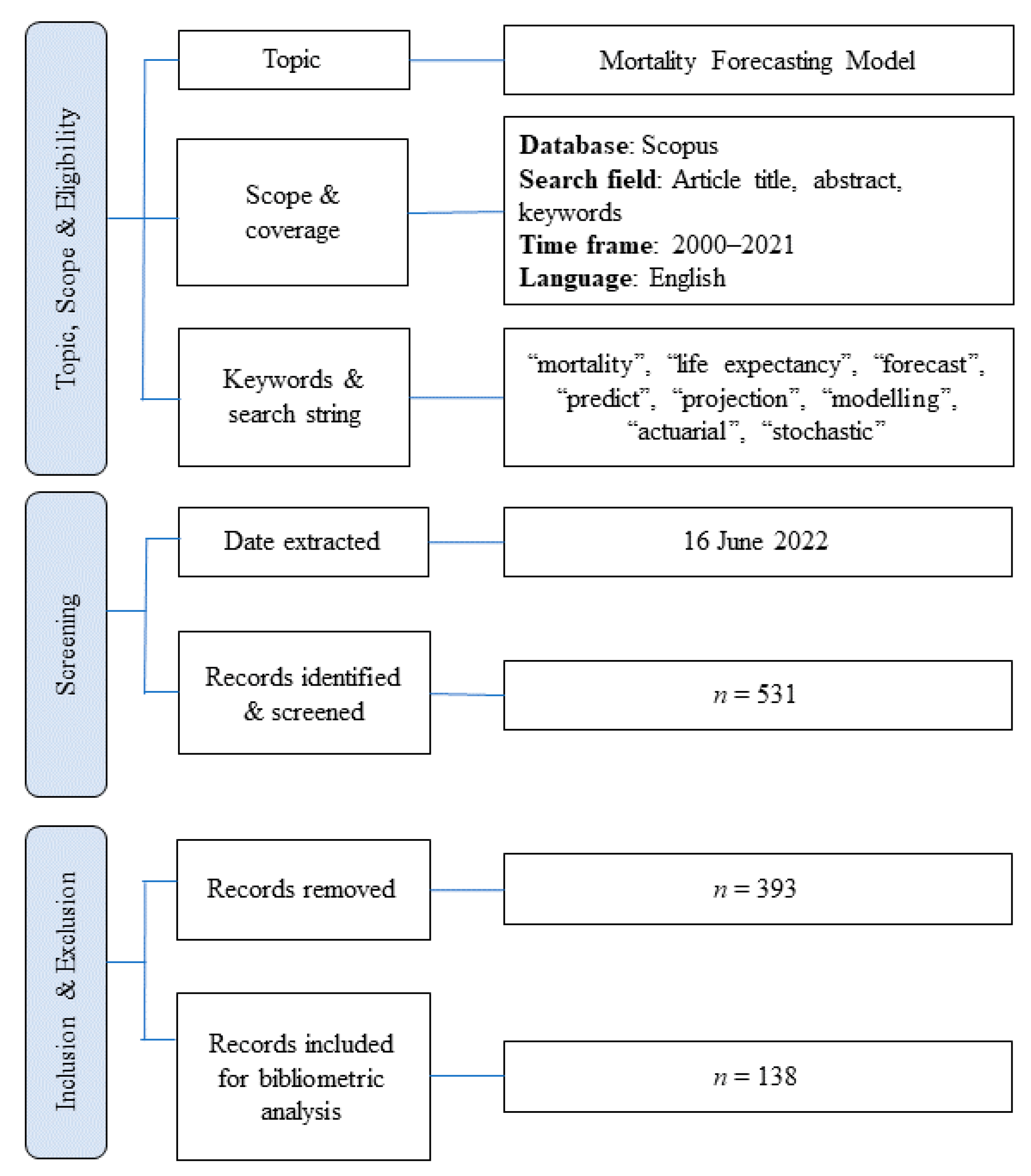
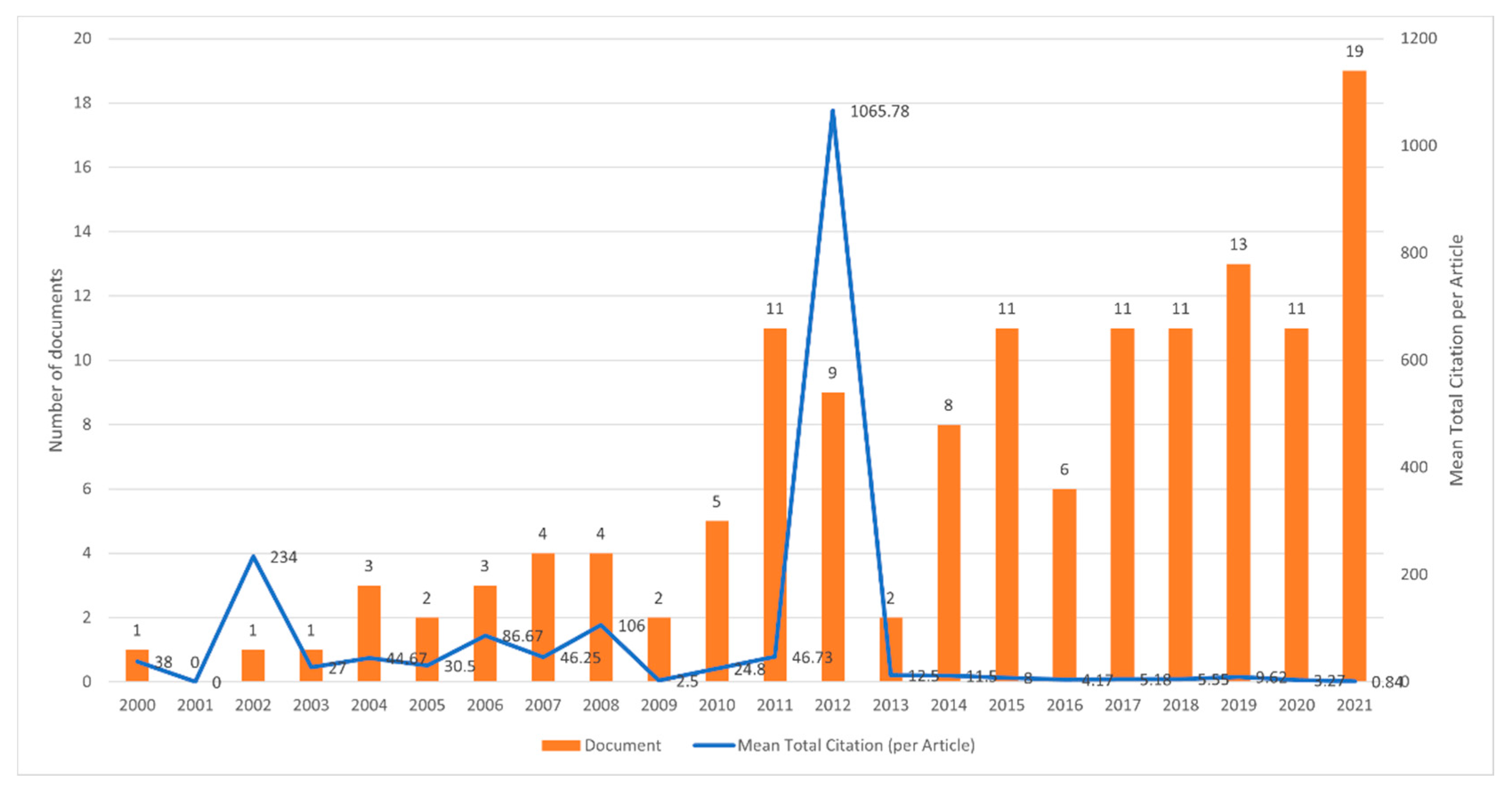
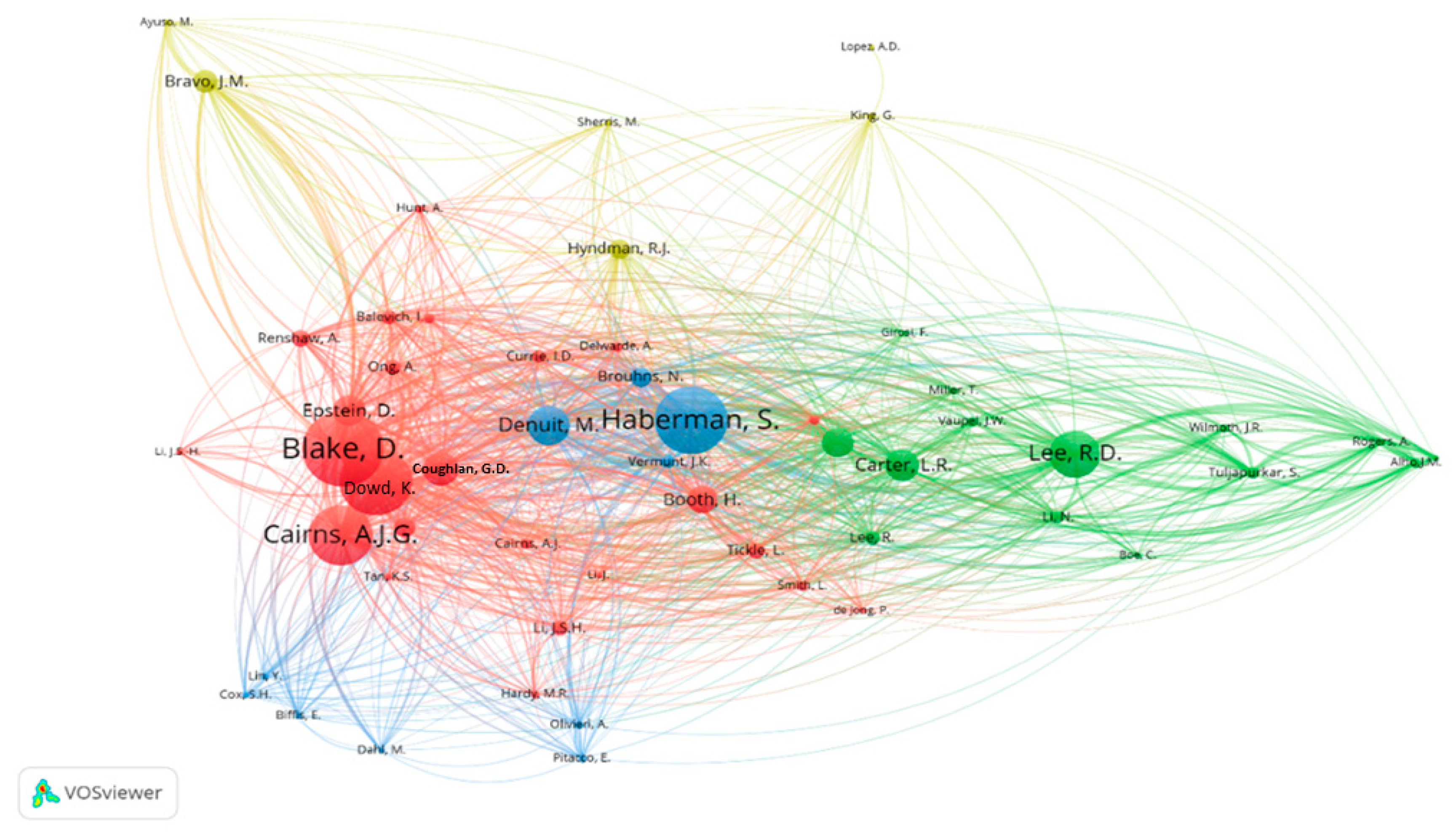
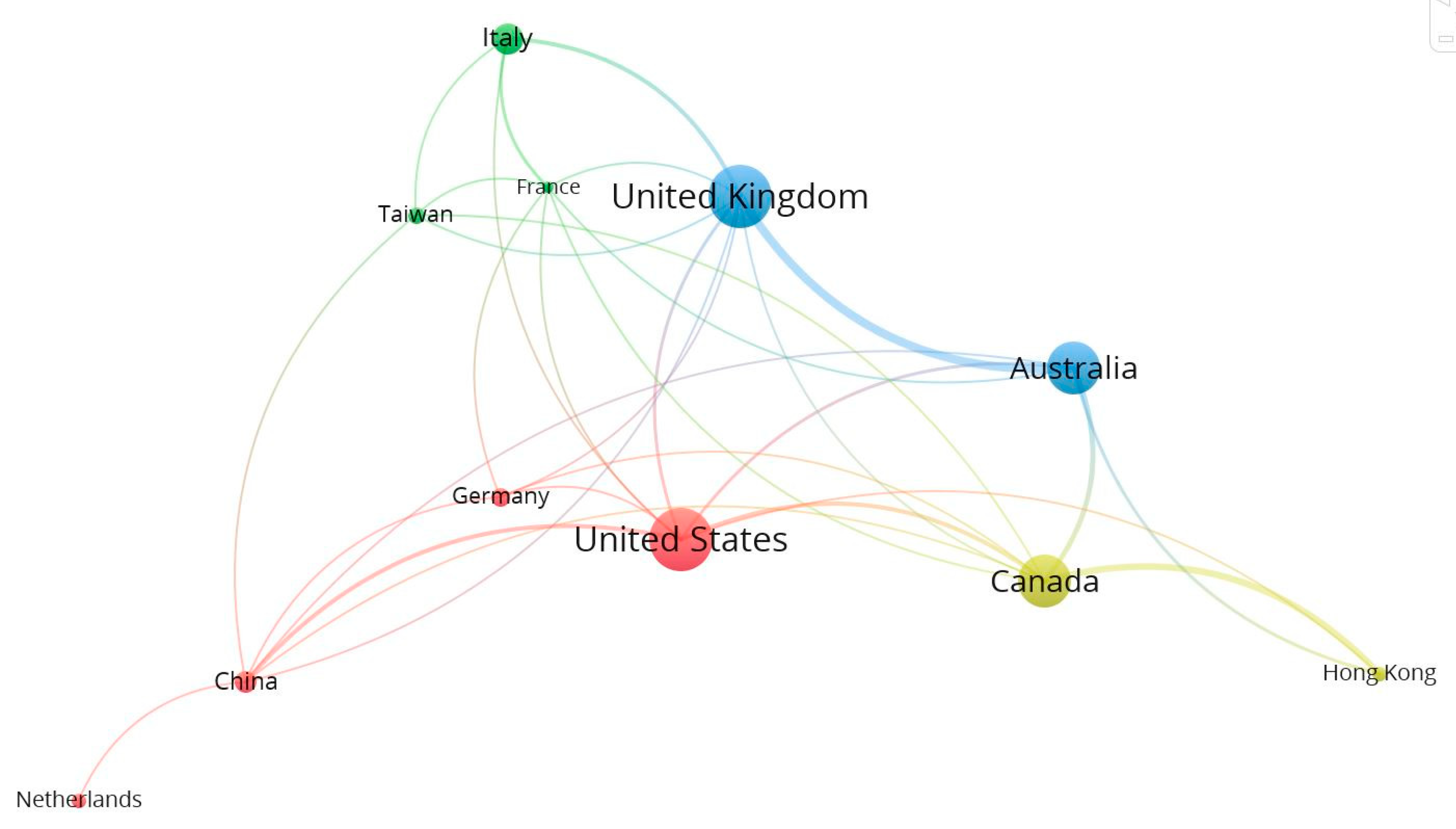
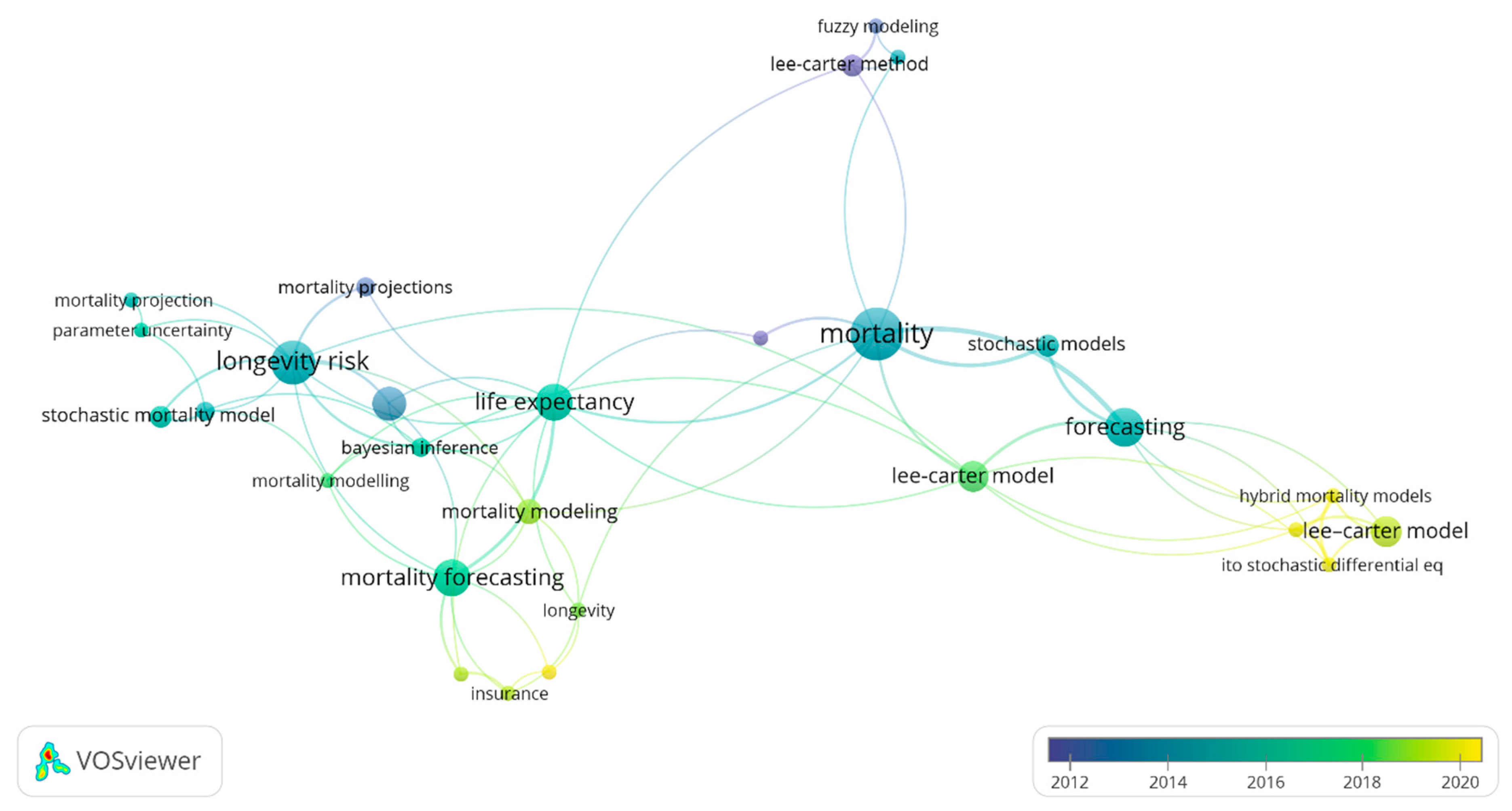
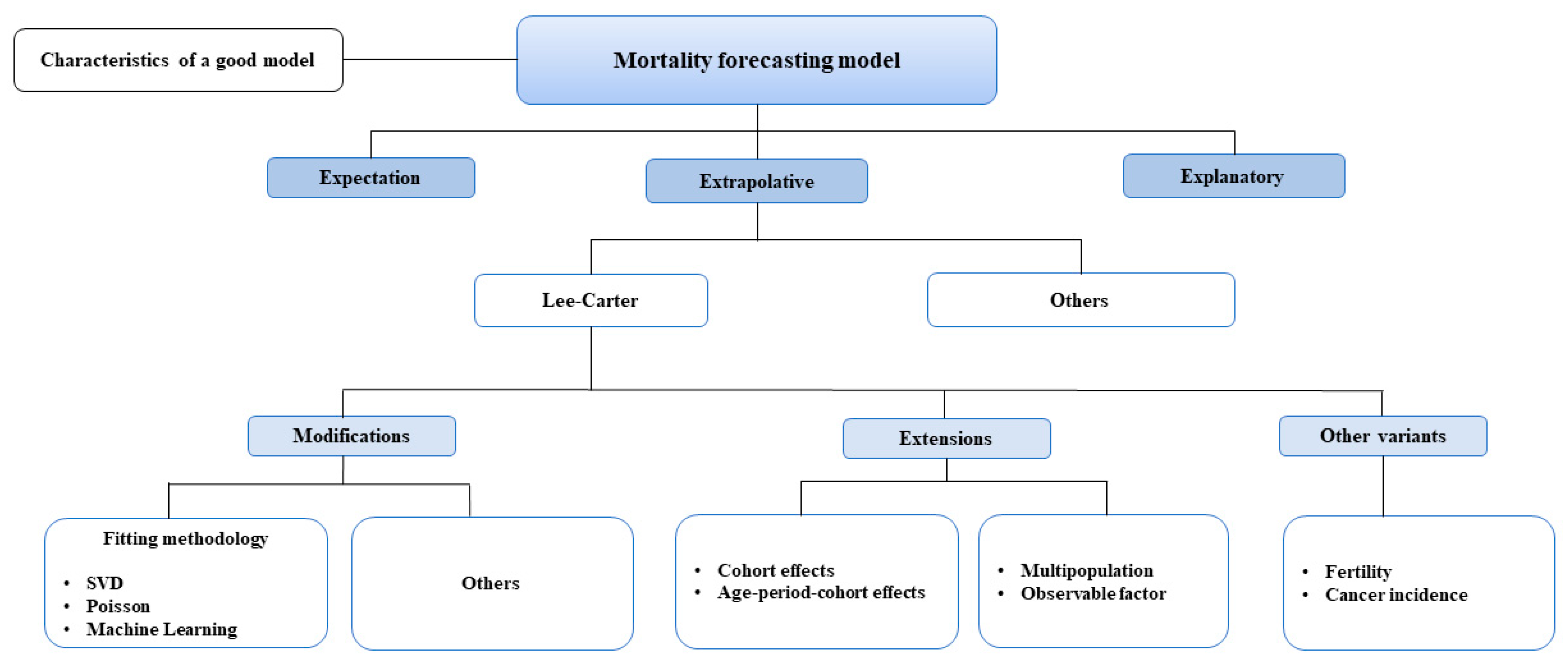
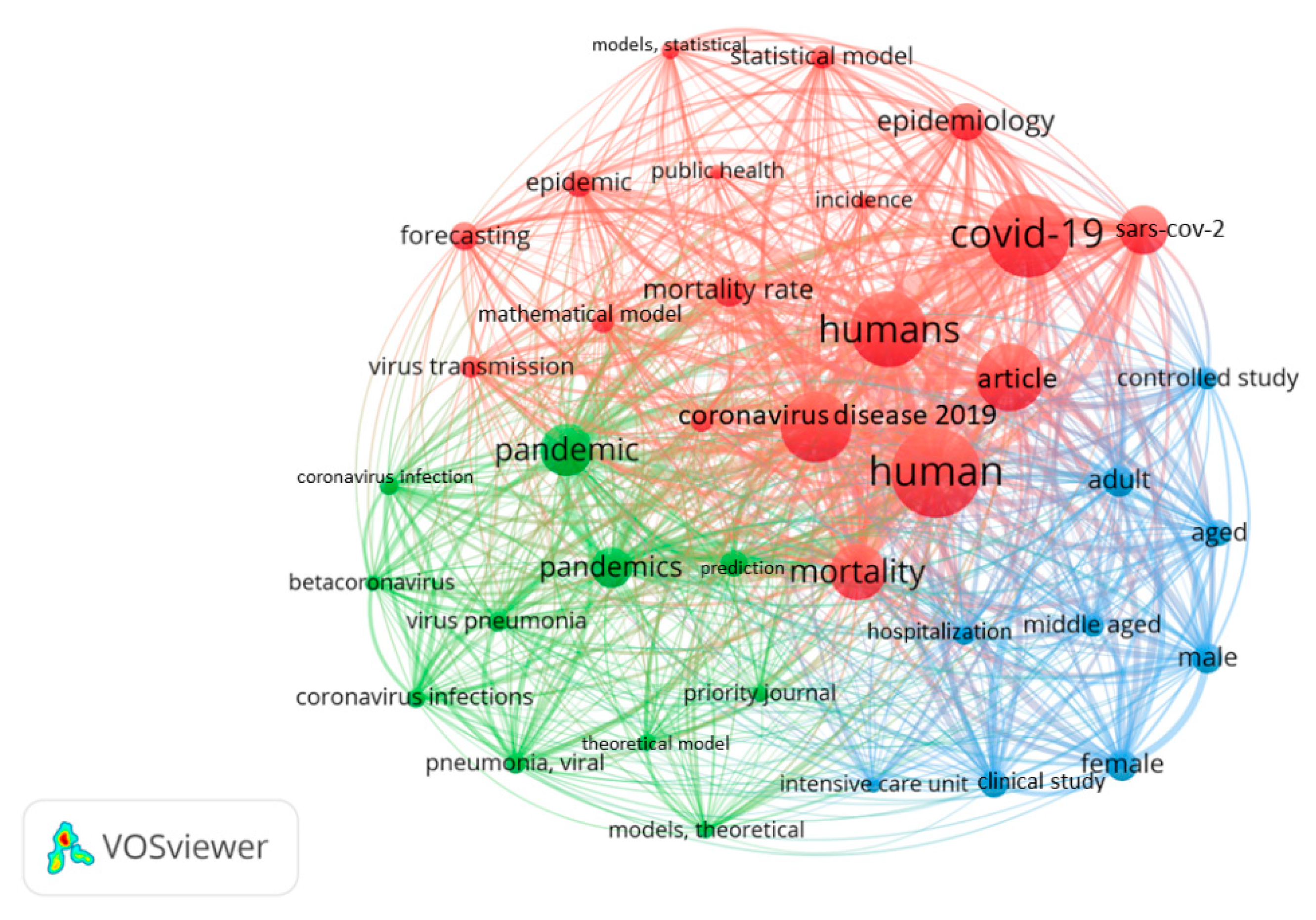
| Document Type | Frequency | Percentage (%) |
|---|---|---|
| Article | 115 | 83.3 |
| Conference paper | 20 | 14.5 |
| Book chapter | 2 | 1.5 |
| Review | 1 | 0.1 |
| Total | 138 | 100.00 |
| Most Active | Most Cited | |||
|---|---|---|---|---|
| Author | Documents | Author | Citations | Cluster |
| Li J.S.H. | 9 | Blake D. | 256 | 1 |
| Chan W.S. | 6 | Dowd K. | 229 | 1 |
| Russolillo M. | 6 | Haberman S. | 229 | 3 |
| Li Y. | 5 | Cairns A.J.G. | 202 | 1 |
| Bravo J.M. | 4 | Lee R.D. | 160 | 2 |
| Cairns A.J.G. | 4 | Denuit M. | 132 | 3 |
| Li H. | 4 | Coughlan G.D. | 112 | 1 |
| O’Hare C. | 4 | Carter L.R. | 106 | 2 |
| Shevchenko P.V. | 4 | Epstein D. | 105 | 1 |
| Tsai C.C.L. | 4 | Renshaw A.E. | 99 | 1 |
| Source | NP | TC | Quartile (2021) |
|---|---|---|---|
| Insurance: Mathematics and Economics | 21 | 544 | Q1 |
| North American Actuarial Journal | 14 | 131 | Q2 |
| Risks | 9 | 37 | Q2 |
| Scandinavian Actuarial Journal | 5 | 136 | Q2 |
| Annals of Thoracic Surgery | 4 | 311 | Q1 |
| ASTIN Bulletin | 4 | 173 | Q1 |
| European Actuarial Journal | 4 | 34 | Q2 |
| Annals of Actuarial Science | 3 | 6 | Q2 |
| Geneva Papers on Risk and Insurance: Issues and Practice | 3 | 56 | Q2 |
| International Journal of Forecasting | 3 | 198 | Q1 |
| Country | Documents | TLS | Citations | Cluster |
|---|---|---|---|---|
| United Kingdom | 26 | 19 | 700 | 3 |
| United States | 26 | 14 | 1153 | 1 |
| Australia | 22 | 19 | 310 | 3 |
| Canada | 22 | 18 | 350 | 4 |
| Italy | 13 | 7 | 182 | 2 |
| China | 9 | 9 | 115 | 1 |
| Germany | 8 | 5 | 72 | 1 |
| Taiwan | 7 | 5 | 139 | 2 |
| The Netherlands | 6 | 1 | 97 | 1 |
| Hong Kong | 6 | 9 | 42 | 4 |
| No | References | Title | Source | TC |
|---|---|---|---|---|
| 1 | Karhade et al. (2019) | Predicting 90-Day and 1-Year Mortality in Spinal Metastatic Disease: Development and Internal Validation | Neurosurgery | 70 |
| 2 | Villegas et al. (2018) | StMoMo: Stochastic mortality modeling in R | Journal of Statistical Software | 22 |
| 3 | Fuller et al. (2016) | Long-Term Survival Following Traumatic Brain Injury: A Population-Based Parametric Survival Analysis | Neuroepidemiology | 17 |
| 4 | Levantesi and Pizzorusso (2019) | Application of machine learning to mortality modeling and forecasting | Risks | 14 |
| 5 | Boonen and Li (2017) | Modeling and Forecasting Mortality With Economic Growth: A Multipopulation Approach | Demography | 13 |
| 6 | Li et al. (2019) | A forecast reconciliation approach to cause-of-death mortality modeling | Insurance: Mathematics and Economics | 12 |
| 7 | Tsai and Lin (2017) | A Bühlmann Credibility Approach to Modeling Mortality Rates | North American Actuarial Journal | 12 |
| 8 | Bravo (2020) | Longevity-linked life annuities: A bayesian model ensemble pricing approach | Proceeding of 20th Conference of the Portuguese Association of Information Systems | 10 |
| 9 | Bozikas and Pitselis (2018) | An empirical study on stochastic mortality modelling under the age-period-cohort framework: The case of Greece with applications to insurance pricing | Risks | 9 |
| 10 | Ludkovski et al. (2018) | Gaussian process models for mortality rates and improvement factors | ASTIN Bulletin | 8 |
Publisher’s Note: MDPI stays neutral with regard to jurisdictional claims in published maps and institutional affiliations. |
© 2022 by the authors. Licensee MDPI, Basel, Switzerland. This article is an open access article distributed under the terms and conditions of the Creative Commons Attribution (CC BY) license (https://creativecommons.org/licenses/by/4.0/).
Share and Cite
Redzwan, N.; Ramli, R. A Bibliometric Analysis of Research on Stochastic Mortality Modelling and Forecasting. Risks 2022, 10, 191. https://doi.org/10.3390/risks10100191
Redzwan N, Ramli R. A Bibliometric Analysis of Research on Stochastic Mortality Modelling and Forecasting. Risks. 2022; 10(10):191. https://doi.org/10.3390/risks10100191
Chicago/Turabian StyleRedzwan, Norkhairunnisa, and Rozita Ramli. 2022. "A Bibliometric Analysis of Research on Stochastic Mortality Modelling and Forecasting" Risks 10, no. 10: 191. https://doi.org/10.3390/risks10100191
APA StyleRedzwan, N., & Ramli, R. (2022). A Bibliometric Analysis of Research on Stochastic Mortality Modelling and Forecasting. Risks, 10(10), 191. https://doi.org/10.3390/risks10100191






